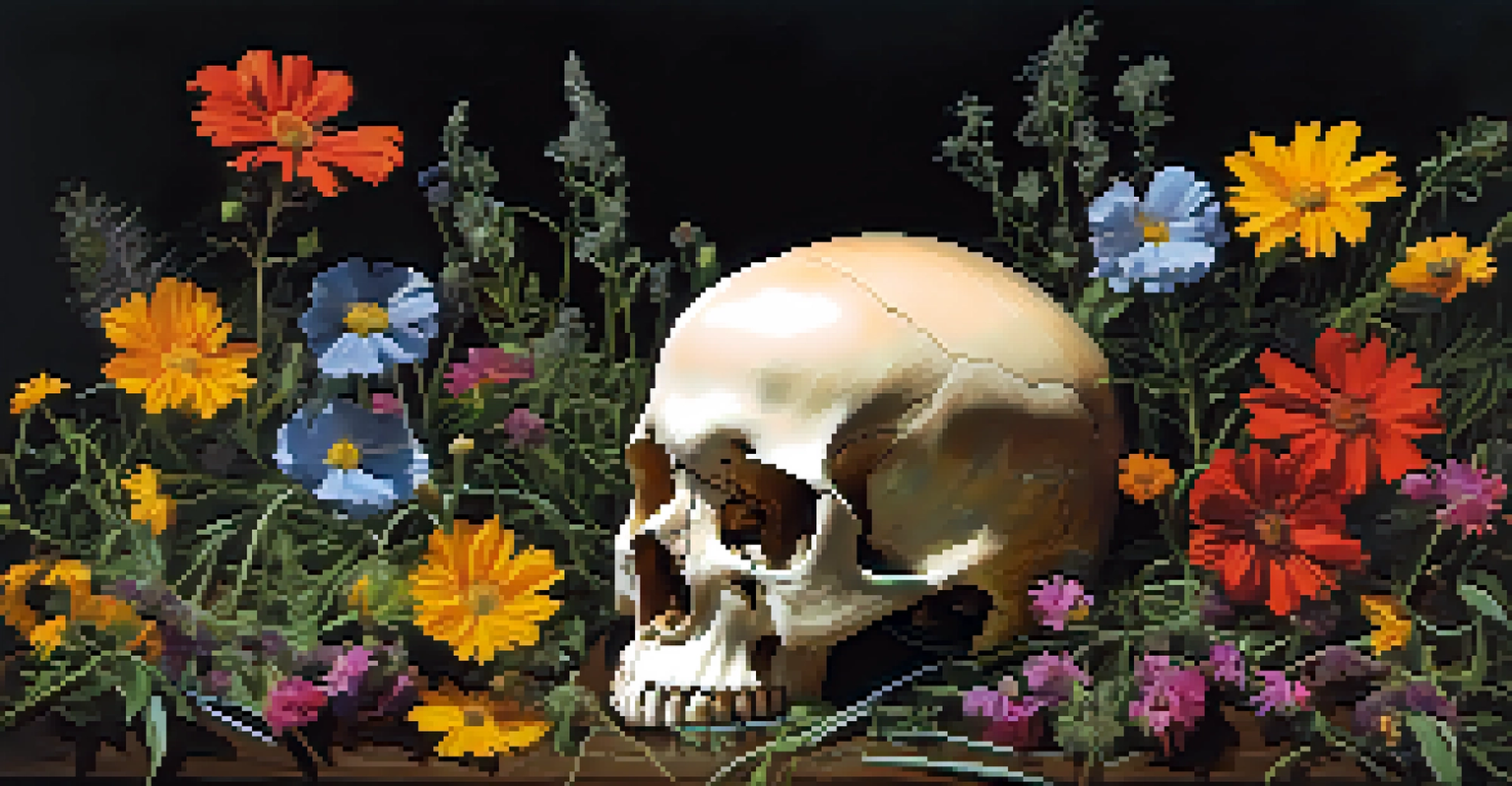Symbolism in Art: Conveying Deep Emotional Narratives

Understanding Symbolism: The Language of Art
Symbolism in art acts like a secret language, allowing artists to convey complex ideas and emotions without words. Think of it as an artist's way of speaking to the viewer's heart, using shapes, colors, and objects to relay deeper meanings. Just as a poet uses metaphors, artists embed symbols within their work to evoke feelings, provoke thought, and tell stories that resonate on a personal level.
Art is the most beautiful of all lies.
For example, a red rose often symbolizes love, while a skull might represent mortality. These associations can vary across cultures, adding layers of meaning to the artwork. When we recognize these symbols, we unlock a richer understanding of the piece, revealing the emotional narratives that the artist intended to share.
Related Resource
In essence, symbolism transforms art from mere visual representation into a powerful medium for storytelling. It invites viewers to look beyond the surface and engage with the deeper emotional currents flowing through the artwork.
Historical Context: Symbolism Through the Ages
Throughout history, symbolism has played a crucial role in the evolution of art. From the ancient hieroglyphs of Egypt to the intricate iconography of the Renaissance, artists have utilized symbols to communicate messages that transcend time and language. This historical context enriches our appreciation of how symbolism has shaped artistic expression.

Take, for instance, the use of light and dark in Baroque paintings to symbolize the struggle between good and evil. Artists like Caravaggio masterfully manipulated light to create dramatic contrasts, guiding viewers' emotions and interpretations. Such techniques not only enhanced the visual impact but also deepened the narrative embedded within the artwork.
Symbolism: Art's Secret Language
Symbolism in art allows artists to convey complex emotions and narratives through shapes, colors, and objects, creating a deeper connection with viewers.
In modern art, symbolism continues to thrive, often reflecting contemporary social and personal issues. Artists like Frida Kahlo used symbols from her own life to explore themes of identity, pain, and feminism, showcasing that the emotional narratives conveyed through art are ever-evolving and deeply personal.
Color as Symbolism: Emotional Resonance in Hues
Color is a powerful tool in the symbolic language of art, capable of evoking strong emotional responses. Each hue carries its own set of associations; for instance, blue often represents calmness or sadness, while yellow can symbolize joy and optimism. Artists carefully choose their color palettes to enhance the emotional narrative of their work, creating a visual dialogue with the viewer.
The artist is not a special kind of person; rather, each person is a special kind of artist.
Consider Vincent van Gogh's use of vibrant yellows and deep blues in paintings like 'Starry Night.' The contrasting colors not only create a striking visual experience but also evoke feelings of both turmoil and tranquility. This interplay of color invites viewers to explore their own emotions in relation to the artwork.
Related Resource
By understanding the emotional weight of colors, we can better appreciate how artists communicate their messages. The next time you view a piece of art, pay attention to the colors used—what feelings do they stir within you? This exploration can lead to a deeper connection with the artwork and its narrative.
Common Symbols and Their Meanings in Art
Certain symbols appear frequently in art, each carrying its own set of meanings and emotional connotations. For example, the owl is often associated with wisdom, while the butterfly symbolizes transformation and rebirth. These symbols can create a shared understanding among viewers, allowing for a collective emotional experience.
Artists may also repurpose traditional symbols to convey new meanings. For instance, the use of chains in contemporary art can represent oppression, while flowers might signify hope or renewal. By reinterpreting these symbols, artists can engage in dialogue about current social issues, adding layers of relevance to their work.
Historical Roots of Symbolism
Throughout history, symbolism has been essential in art, evolving from ancient practices to modern expressions that reflect contemporary social issues.
Recognizing these common symbols enriches our viewing experience, enabling us to connect with the art on a deeper level. Next time you encounter a painting or sculpture, take a moment to reflect on the symbols present—what stories might they be telling?
The Role of Personal Experience in Symbolism
An artist's personal experiences often shape the symbolism within their work, creating a unique emotional narrative. For instance, an artist who has faced loss may incorporate symbols of grief, such as wilted flowers or stormy skies, to convey their feelings. This personal touch invites viewers to see the artwork through the artist's eyes, fostering empathy and connection.
Similarly, viewers bring their own life experiences to their interpretation of art. A symbol that represents one emotion for the artist may evoke an entirely different response in a viewer. This subjective nature of symbolism allows each individual to engage with the artwork uniquely, creating a shared yet diverse emotional experience.
Related Resource
By acknowledging the interplay between an artist's intent and a viewer's perception, we deepen our understanding of the emotional narratives in art. This dynamic relationship enriches the experience of both creating and appreciating art, showcasing the beauty of personal expression.
Symbolism in Contemporary Art: New Narratives Emerge
In contemporary art, symbolism has adapted to reflect modern themes and societal issues. Artists often use symbols to comment on topics like identity, technology, and environmental concerns. This evolution demonstrates how art remains a relevant and powerful medium for expressing complex emotional narratives in an ever-changing world.
Take, for example, the use of social media symbols in digital art. Artists may incorporate icons like hashtags or emojis to explore the impact of technology on human connection and communication. These contemporary symbols resonate with a generation that navigates a digital landscape, creating a shared understanding of current emotional experiences.
Personal Experience Shapes Meaning
An artist's personal experiences significantly influence the symbolism in their work, while viewers' interpretations create a unique emotional dialogue.
As we engage with contemporary art, we find that symbolism continues to play a vital role in conveying deep emotional narratives. By embracing new symbols and reinterpreting traditional ones, artists invite us to reflect on our own lives, encouraging dialogue about the world around us.
Interpreting Symbolism: A Personal Journey
Interpreting symbolism in art is a deeply personal journey that invites us to explore our own emotions and experiences. As we engage with a piece, we may find ourselves drawn to specific symbols that resonate with our unique stories. This personal connection can transform the act of viewing art into an intimate exploration of our inner selves.
Consider visiting an art gallery with an open mind, allowing the symbolism to speak to you. As you observe various pieces, take note of the symbols that capture your attention. Reflect on what they evoke within you—do they remind you of a cherished memory, a personal struggle, or a moment of joy? This process can lead to profound insights and emotional revelations.

Ultimately, the beauty of symbolism in art lies in its ability to evoke a spectrum of emotions. By approaching art with curiosity and a willingness to explore, we can uncover the deep narratives that connect us all, enriching our understanding of both the artwork and ourselves.